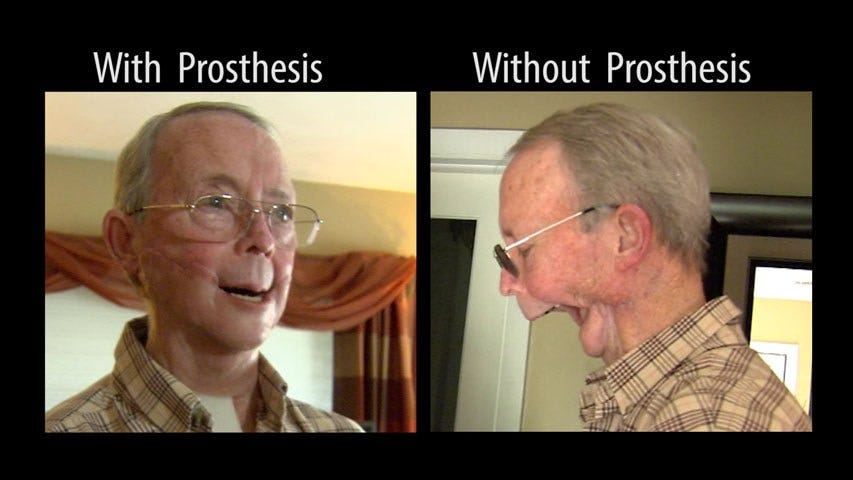IU-Developed Method Restores Patient’s Face
 Dr. Bellicchi says Anderson has been "incredibly patient" and enthusiastic during the process.
Dr. Bellicchi says Anderson has been "incredibly patient" and enthusiastic during the process.
Subscriber Benefit
As a subscriber you can listen to articles at work, in the car, or while you work out. Subscribe NowFighting cancer resulted in a devastating physical loss for a 68 year-old Evansville man; Shirley Anderson is missing the entire lower portion of his face. While he has the top half of his mouth, the bottom half—including lower jaw, lower lip, bottom teeth and chin—were lost to bone death after radiation therapy. The task of creating a prosthesis to rebuild his face was “overwhelming” for an Indiana University dentist. Knowing traditional methods wouldn’t accomplish the task at hand, Dr. Travis Bellicchi turned to artists for help, and the unlikely team created a groundbreaking method that has changed Anderson’s life and is now being perfected to help many more patients.
Anderson was the first facial prosthetic patient for Bellicchi, who was just getting his feet wet in the specialty. The seemingly insurmountable challenge meant he’d have to produce the largest facial prosthetic ever made at the IU School of Dentistry.
“That’s why I sought out a better way,” says Bellicchi, a second-year maxillofacial prosthodontics resident. “If we were just making an ear or nose, the traditional method is adequate, but for something on a larger scale, it just isn’t sufficient.”
The task demanded medical expertise and artistic prowess to, essentially, sculpt Anderson a new lower face. Bellicchi found the partners he needed in—surprisingly—an undergraduate student learning how to digitally create video game characters and a faculty member, both in the Department of Media Arts and Science at the IU School of Informatics and Computing at IUPUI.
Leaving conventional methods behind, Bellicchi believes the team is the first to create a prosthetic using a combination of new digital design technologies. Media Arts and Science Lecturer Zebulun Wood says they used photogrammetry to scan and create a “topographic map” of Anderson’s face. The team converted that to a digital model, used various software to help complete the prosthetic’s appearance, then 3D printed the mold for what would become Anderson’s new lower face.
“The workflow is what’s totally unique; we’re not doing any of the traditional workflow to get to the final result, which is a silicone prosthesis,” says Bellicchi. “I found a team that can do really impressive organic modeling for human structure, and I can focus on just taking care of the patient, rather than learning how to become a sculptor myself.”
Wood says undergraduate student Cade Jacobs is one of the first Media Arts and Science students to connect their digital artistic skills—typically used to create video game or film characters—to help patients.
“I’ve strayed away entirely from anything entertainment and put all of my focus into the medical field now,” says Jacobs. “It’s exciting to know a skillset like mine in digital arts and sculpture can be useful in the medical industry and make a difference for patients.”
The collaboration has been so successful that the team is launching an effort to create new classes in the School of Informatics and Computing that would bring clinicians and Media Arts and Science students together to do similar work. The project may also establish a center to help clinicians from any specialty create digital designs.
“[Jacobs] is absolutely on the level with us as a collaborator and a colleague; this doesn’t feel like a mentor-to-mentee relationship,” says Bellicchi. “He’s able to make decisions about the cases we’re working on, and he brings me new ideas that I hadn’t thought of that I’m so impressed by. We’re using his design ideas for patient care. To make decisions that affect change for cancer patients and facial trauma victims is a very exciting opportunity.”
In addition to delivering two prosthetics to Anderson, the team has used the method—which they’ve named the IU Shirley Technique—to help five more patients. The teams says it’s also a more streamlined process for the patient and allows designers to create a prosthetic in a matter of days, rather than weeks or months. The collaborators are applying for grants to standardize the method, so it can be expanded to impact more patients.
“I’m most excited about refining the process to the point that we can share it with other clinicians and health care providers as a comprehensive solution…and they’re able to do this work with their patients at a different facility,” says Bellicchi. “Doing it here for our patients in Indiana is wonderful, but I would love to be able to help patients on a bigger scale.”
Bellicchi says he’s also working with the mechanical engineering department to make the prosthetic move more naturally with Anderson’s face.
Bellicchi says the project could be a springboard to establish a center that helps clinicians from any specialty create digital designs.
Wood says informatics’ role in solving problems is more than just numbers and analyzing big data.
